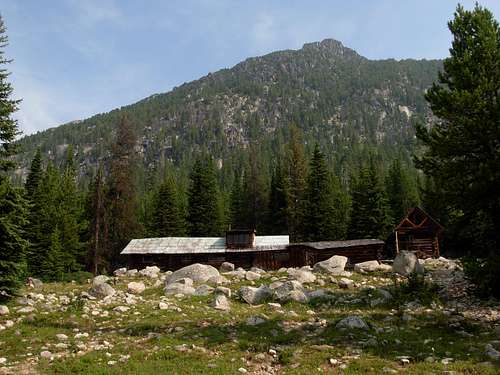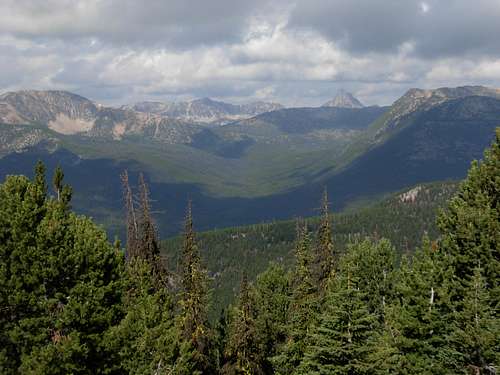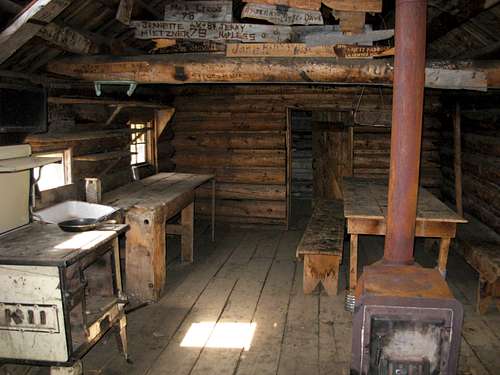|
|
Logistical Center |
|---|---|
|
|
48.97689°N / 120.13258°W |
|
|
Hiking, Mountaineering, Trad Climbing, Bouldering, Mixed, Scrambling |
|
|
Summer, Fall |
|
|
Overview
Tungsten Mine Camp is a logistical center located in the eastern area of the Pasayten Wilderness of Washington. Rich in history, surrounded by tranquil beauty, and close to several major hiking and climbing areas, Tungsten Mine Camp is an ideal hub for potential summiters in the Pasayten Wilderness.Tungsten Mine Camp was named for the tungsten ore mineral that was discovered and mined for many years in the immediate area of the camp. The camp is located on the south slopes of Wolframite Mountain. Wolframite is the official name for iron manganese tungstate, the most important type of tungsten ore mineral and the reason why tungsten is identified with a "W" on the Periodic Table of Elements.
Between 1898 and 1904, tungsten deposits were discovered on the slopes of Wolframite Mountain while the U.S.-Canada Boundary Line was being surveyed and slashed-out. In 1906, mining claim sites were developed and established. Herb Curtis, one of the crew members for the boundary project, realized the potential of the discovery and became part-owner of the mine that would begin operating on the south side of the mountain in 1908. This mine had many names during the years, including Wolframite Mine, Boundary Mine, and Tungsten Mine. Other smaller mines were also established in the area surrounding the mountain, as well. Ultimately, the mines established around Wolframite Mountain were the only sites to produce any substantial tungsten ore minerals (including scheelite, for which nearby Scheelite Pass was named) in the Pasayten Wilderness. In effect, the mining operations at and around Tungsten Mine Camp led to the establishment of further exploration of the Pasayten Wilderness region and the creation of routes within it.
Between 1915 and 1918, mining operations at Tunsten Mine Camp boomed. An influx of workers and settlers entered the region. All materials used in and for the Tungsten Mine were hauled by horses, taking four days in each direction to travel. In 1915, during a winter of record snowfall at that time, an estimated $10,000 was spent to create a “snow road” from the nearest town (Loomis) to the Tungsten Mine at Wolframite Mountain; all grades, fills, and cuts for the road were completely built of snow. By 1916, 80 men were employed at the mine. By 1920, the mine had produced six carloads of hand-sorted wolframite and tungsten. Most of that ore was shipped to Germany as a steel hardener for the country’s munitions.
However, the ore production and operation of the mine proved too costly to maintain. The angle of the ore veins and the remoteness of the mining location greatly limited production. The mine operated periodically throughout the years, even shipping a record 30 tons of ore in 1936 (but at a financial loss). In the early 1940s, a newer 10-ton-per-day spiral concentrator was added to the mine camp. This allowed the mine to produce 300 tons of more ore, before the mine later had to cease its operations as a result of large tungsten deposits found in more-easily accessible locations in Colorado. When the Tungsten Mine first started its operations the price of tungsten was $5 per pound, but at the time the mine closed the price of tungsten had fallen to less than $1 per pound. The production value of the Tungsten Mine, had it continued it operations, would have been at a 5x loss.
After the Tungsten Mine ceased operations, Tungsten Mine Camp and the surrounding area was mostly abandoned and ignored for many years. However, due to the popularity of hiking and climbing in the Pasayten Wilderness, Tungsten Mine Camp and its surrounding area has been increasingly gaining recognition once again. The defunct campsite, a semi-popular destination for hikers in the Pasayten Wilderness, is still located at the junction (6750’ elevation) of Tungsten Creek Trail #534 and Boundary Trail #533. This is significant to many backcountry enthusiasts because the Boundary Trail is one of the major passageways of the Pacific Northwest Trail that travels from Montana to the Pacific Ocean.
Today, two large buildings remain at the mine camp, as well as some machinery, collapsed/sealed mineshafts, and brick remnants of the original mill. Old rusty remnants of the mining operations can be found throughout the vicinity of the Tungsten Mine Camp and the south side of Wolframite Mountain. The site of the Tungsten Mine operations is a short walk below the Tungsten Mine Camp, down the slope from the camp.
Tungsten Mine Camp is centrally located for several large and/or important summiting opportunities in the region. Most notably are the peaks in the immediate area that are all over 8000' elevation. One such peak is Wolframite Mountain, which as mentioned earlier looms above the campsite to the north. Located south of Tunsten Mine Camp is the next-closest peak, Apex Mountain, which is the 18-tallest peak in the Pasayten Wilderness and just barely misses the official Top-100 peak list for Washington. Located only several miles west of Tungsten Mine Camp are more popular hiking/climbing destinations Cathedral Peak and Amphitheater Mountain, both of which are Top-100 peaks of Washington. Located only several miles east of Tungsten Mine Camp is Bauerman Ridge, the 23rd-most prominent peak in the Pasayten Wilderness.
Other notable peaks that are within a day's journey of Tungsten Mine Camp include Teapot Dome, Windy Peak, Remmel Mountain, and Armstrong Mountain, among many others. Summiting mountains within the region ranges from very easy to very difficult, depending on peaks and routes involved. This helps make Tungsten Mine Camp a preferred logistical center for many hikers, mountaineers, climbers, and summiters of all levels of expertise.
------------
Due to hiking distances, unpredictable weather patterns, and long winter seasons, Tungsten Mine Camp is best recommended to be attempted between late June to early September. Check with the Okanogan National Forest's Tonasket Ranger District for current trail, snow, and weather conditions at Tungsten Mine Camp.
Tungsten Mine Camp, and the major routes leading to the area, can be found on Green Trails Map #20.
Getting There
OPTION #1:
From Tonasket, WA:
1) Drive Okanogan County Road 9437 (Hwy 7) north about 5.5 miles to County Road 9425.
2) Turn east on County Road 9425 and travel about 12 miles to Loomis.
3) From Loomis, continue on County Road 9425 for about 2 miles to County Road 4066.
4) Turn east on County Road 4066, which becomes Forest Service Road 39 (Toats Coulee Road), and continue for 20 miles to Long Swamp Campground.
5) Take FS Road 39-300 for 3 miles to the Chewuch Trailhead (~5600’ elevation).
6) Hike Cathedral Driveway Trail #510A for 2.2 miles, to the intersection with Chewuch Trail #510 (~4200’ elevation).
7) Hike Chewuch Trail #510 for 3.6 miles, to the intersection with Tungsten Creek Trail #534 (~4700’ elevation).
8) Hike Tungsten Creek Trail #534 for 6.2 miles, to the intersection with Boundary Trail #533 (~6750’ elevation). This intersection is located at the site of the Tungsten Mine Camp, on the south side of Wolframite Mountain.
------------
OPTION #2:
From Winthrop, WA:
1) Drive north on Okanogan County Road 1213 (West Chewuch Road) until it joins Forest Service Road 51.
2) Then drive for 29 miles to the Thirtymile Trailhead (~3600’ elevation).
3) Hike Chewuch Trail #510 for 8.8 miles, to the intersection with Tungsten Creek Trail #534 (~4700 elevation).
4) Hike Tungsten Creek Trail #534 for 6.2 miles, to the intersection with Boundary Trail #533 (~6750’ elevation). This intersection is located at the site of the Tungsten Mine Camp, on the south side of Wolframite Mountain.
Red Tape
A backcountry permit (free) must be filled-out at any of the major trailheads prior to entering the area.However, Tungsten Mine Camp lies within a "Fee Use" zone. As of 2009, the fee had been $5 per day, and total amount must be submitted at the trailhead prior to beginning the hike.
Special notice regarding Tungsten Mine Camp:
There are two cabins available at Tungsten Mine Camp. Please note that field mice are notoriously present in either cabin, even if apparent entrances and openings are closed. It is recommended to try to store food by hanging from various nails in the ceilings and posts within the cabins, or use the "caged" storage box on the outside of the upper cabin. Remember, mice are not afraid to gnaw through gear that has the scent of food. Store gear off floors, as a precaution.
Camping
There are two cabins located at Tungsten Mine Camp, available for overnight stays. The larger cabin has multiple rooms: an entrance room, two bedrooms, and a dining room. Most single-occupants prefer to sleep on the table in the dining room (see "Red Tape" section for the reason why), and the bedrooms would most likely require sleeping on the floor (which is not recommended). The smaller cabin, just up the hill and behind the larger cabin, has a single room containing two single beds and one bunk bed. Cabin sleeping spots are on a "first come, first served" basis, with no reservations. Campsites are found in many places around Tungsten Mine Camp, outside of the cabins.There are no fees to stay at Tungsten Mine Camp.







